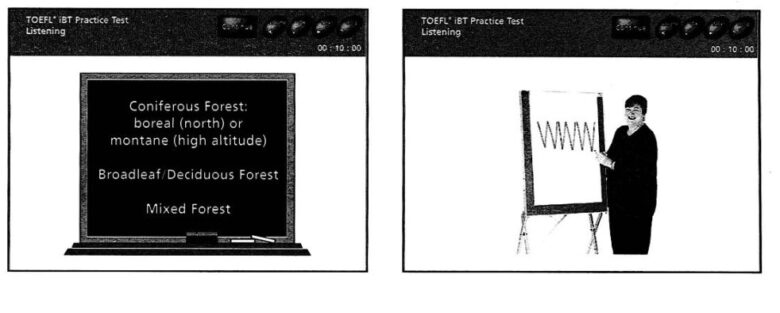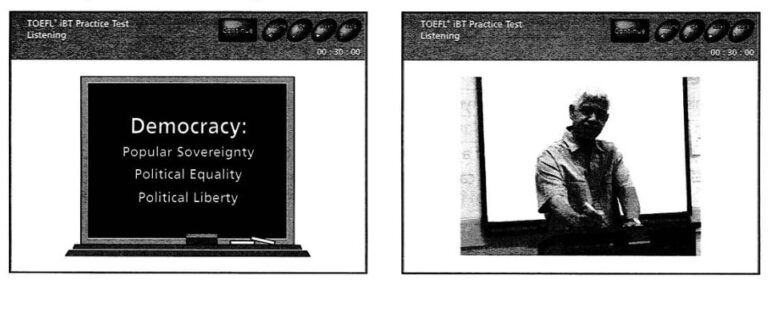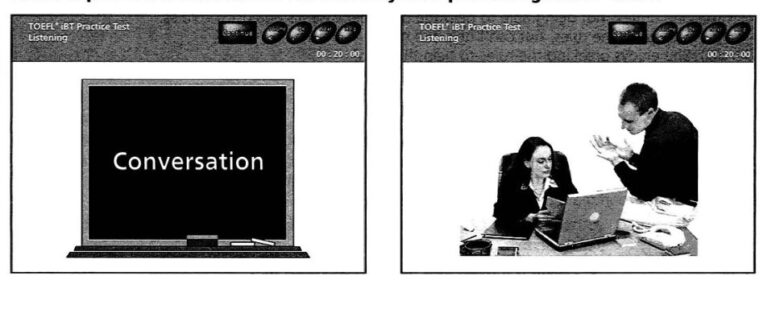TOEFL IBT Listening Practice Test 21 from Sharpening Skills for the TOEFL iBT four practice tests by Jeff Zetter & Micheal Pederson
Listening Section Directions
This test measures your ability to understand conversations and lectures in English.The Listening section is divided into 2 separately timed parts. In each part you will listen to 1 conversation and 2 lectures. You will hear each conversation or lecture only one time.
After each conversation or lecture, you will answer questions about it. The questions typically ask about the main idea and supporting details. Some questions ask about a speaker’s purpose or attitude. Answer the questions based on what is stated or implied by the speakers.
You may take notes while you listen. You may use your notes to help you answer the questions. Your notes will not be scored. If you need to change the volume while you listen, click on the Volume icon at the top of the screen.
In some questions, you will see this icon: This means you will hear, but not see, part of the question. Some of the questions have special directions. These directions appear in a gray box on the screen.
Most questions are worth 1 point. If a question is worth more than 1 point, it will have special directions that indicate how many points you can receive. You must answer each question. After you answer, click on Next. Then click on OK to confirm your answer and go on to the next question. After you click on OK, you cannot return to previous questions.
A clock at the top of the screen will show you how much time is remaining. The clock will not count down while you are listening. The clock will count down only while you are answering the questions.
TOEFL IBT Listening Practice Test 21 from Sharpening Skills for the TOEFL iBT four practice tests by Jeff Zetter & Micheal Pederson
Listening 1
Listen to part of a lecture in a biology class. Trade 1
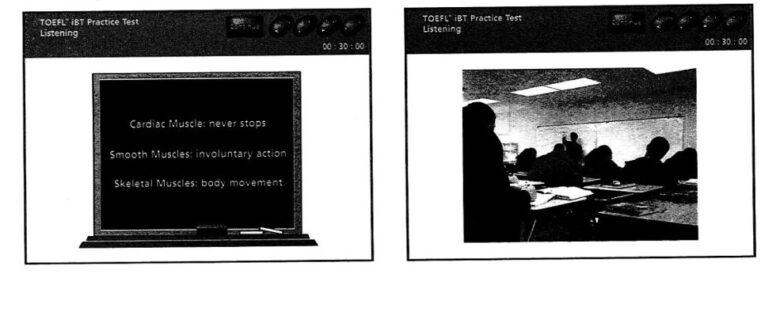
Now get ready to answer the questions. You may use your notes to help you answer.
1. What is the talk mainly about? Trade 2
(A) The reflex actions of muscles
(B) Muscles and how they work
(C) How vertebrates move
(D) Categories of movement
2. What do smooth muscles and striated muscles have in common? Trade 3
(A) They are active at some times and not at others.
(B) Neither type of muscle ever relaxes.
(t) They both can be found in organs of the body- (D) Both types connect internal organs to the skeleton.
3. How does the professor clarify his point about movements that are a mixture of voluntary and involuntary actions? Track 4
(A) By describing how a doctor examines throat muscles
(B) By mentioning the heart muscle
(C) By describing the act of swallowing
(D) By comparing voluntary and involuntary muscles
4. In the lecture, the professor describes three different types of muscles. Indicate to which category each of the following belongs. Track 5
Put an X in the correct column for each word or phrase.
| Cardiac | Striated | Smooth | |
| (A) never rests | |||
| (B) striped | |||
| (C) internal organs | |||
| (D) skeleton | |||
| (E) pupils of the eye |
5. What kind of muscle do people have conscious control over? Track 6
(A) Cardiac muscles
(B) Striated muscles
(C) Smooth muscles
(D) All muscles
Listen again to part of the lecture. Then answer the question. Trade 7
6. Why does the professor mention standing up?
(A) To give the students permission to leave
(B) To complain that students are not paying attention
(C) To give an example of voluntary muscle movement
(D) To demonstrate an action involving all three muscle types
Listening 2
Listen to part of a conversation between a student and a professor. Track 8
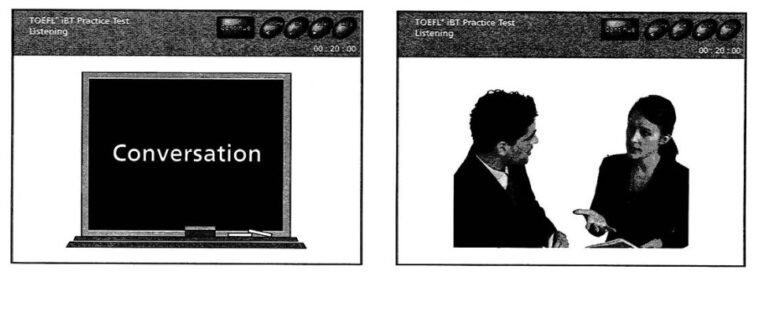
Now get ready to answer the questions. You may use your notes to help you answer.
7. Why does the student go to see her professor? Track 9
(A) Her professor wants to congratulate her.
(B) She wants to tell him she’s withdrawing from an art show.
(C) She needs advice on what to do next.
(D) She wants to thank him for helping her get in the art show.
8. According to the professor, what is true about the Annual Gregory Art Show? Trade 10
(A) The professor is involved in the selection of artists who participate.
(B) Several of the professor’s graduate students received invitations.
(C) It’s a show especially designed for first-year art students.
(D) It’s a great opportunity for art students.
9. Why is the student considering not entering the art show? Track 11
(A) The organizers won’t allow first-year students to win awards.
(B) The organizers don’t respect her professor.
{C) The organizers want to censor one of her paintings.
(D) The organizers don’t believe in stereotypes.
Listen again to part of the conversation. Then answer the question. Track 12
10. What is the professor’s attitude about the student’s participation in the art show?
(A) He believes the student should participate.
(B) He feels that the show’s organizers are being unfair.
(C) He thinks she has made the right decision.
(D) He doesn’t know what the student should do.
Listen again to part of the conversation. Then answer the question. Track 13
11. What does the professor mean when he says this: ?
(A) To be successful, an artist has to know how to draw properly.
(B) Each artist has to find the best place to live and work.
(C) An artist has to decide what he or she will agree to do.
(D) An artist needs to put meaning into every part of a work of art-
12. What will the student probably do next? Track 14
(A) Withdraw from the show
(B) Talk to another professor
(C) Remove controversial parts from her painting
(D) Submit another painting for consideration
Listening 3
Now get ready to answer the questions. You may use your notes to help you answer.
13. What aspect of forests does the professor mainly discuss? Track 16
(A) Their animals
(B> Their geography
(C) Their composition
(D) Their development
14. How does the professor illustrate the value of an inside look at a forest? Track 17
(A) By comparing a forest to the human body
(B) By describing the way a forest looks from outside
(C) By contrasting forests with other geographic features
(D) By explaining how to identify different kinds of trees
15. According to the professor, where are boreal forests most likely to be found? Track 18
(A) The mountains
(B) The temperate zone
(C) The north
(D) The tropics
16. In the lecture, the professor describes some features of broadleaf forests. Indicate whether each of the following is mentioned in the lecture as being characteristic of broadleaf forests. Track 19
Put an X in the YES or NO column for each statement.
Yes No
(A) Usually found in high and cold areas
(B) Also called deciduous forests
(C) Feature trees with long needles
(D) May include such trees as oaks and maples
17. According to the professor, which kind of forest is found mostly in areas with periodic year-round rainfall? Track 20
(A) Mixed forests
(B) Temperate rainforests
(C) Boreal forests
(D) Coniferous forests
Listen again to part of the lecture. Then answer the question. Track 21
18. Why does the professor mention goals, success, and the upper class?
(A) To emphasize that trees deserve respect
(B) To show that trees can think and plan
(C) To make a humorous comparison between trees and people
(D) To illustrate that some trees grow to be taller than others
Listening 4
Now get ready to answer the questions. You may use your notes to help you answer.
1. What aspect of democracy does the professor mainly discuss? Track 23
(A) Its attributes
(B) Its origins
(C) Its benefits
(D) Its dangers
Listen again to part of the lecture. Then answer the question. Track 24
2. What is the professor’s attitude toward democracy in ancient Athens: ?
(A) It involved too many people in decision-making.
(B) It was superior to present-day democracy.
(C) It unfairly kept many people from voting.
(D) It could not produce final decisions about important issues.
3. According to the professor, which of the following is necessary for popular sovereignty? Track 25
(A) A strong leader
(B) Healthy citizens
(C) A democracy
(D) Knowledgeable voters
4. Why does the professor mention the Bill of Rights? Track 26
(A) To show that true democracy requires a constitution
(B) To help define the term “rights”
(C) To support the claim that the US has a strong democracy
(D) To help explain what he means by political liberty
Listen again to part of the lecture. Then answer the question. Track 27
5. Why does the professor say this:
(A) To indicate that money may or may not influence political equality
(B) To indicate that money does not influence democratic elections
(C) To indicate that money gives some people unequal influence in decision-making
(D) To indicate that it is not proper to discuss money and democracy together
6. Based on information in the lecture, indicate whether each statement below expresses a condition necessary for a healthy democracy. Track 28
Put an X in the YES or NO column for each statement.
Yes No
(A) Citizens enjoy material equality.
(B) The government obeys the wishes of the majority.
(C) Citizens enjoy basic liberties.
(D) People govern themselves through direct rule.
Listening 5
Listen to part of a conversation in the university’s Campus Parking Office. Track 29
Now get ready to answer the questions. You may use your notes to help you answer.
7. Why is the student in the Campus Parking Office? Track 30
(A) To register his car
(B) To get a handicapped parking permit
(C) To report a problem with his roommate’s car
(D) To pick up an application form
8. Why does the man have difficulty getting what he wants? Track 31
(A) He broke his ankle.
(B) His roommate is handicapped.
(C) No permit has been issued in his name.
(D) He has forgotten the application form.
9. What information is in the office’s database? Track 32
(A) Names of all students registered at the university
(B) License numbers of all automobiles owned by students
(C) Maps showing parking spaces on the campus
(D) Information from the health services clinic
Listen again to part of the conversation. Then answer the question. Track 33
10. Why does the woman ask the man these questions: f”) ?
(A) To show her concern for his roommate’s health
(B) To decide what type of permit to issue
(C) To find out the reasons for the man’s request
(D) To discourage him from getting a permit for his car.
Listen again to part of the conversation. Then answer the question. Track 34
11. How does the woman feel about registering the handicapped permit for the man’s car?
(A) She is reluctant to break the rules to help him, but she does.
(B) She regrets not being able to help the man, because it’s against the rules.
(C) She hates the rules, but can’t help the man.
(D) She enjoys breaking the rules to help the man.
12. What does the woman offer to do for the man? Trade 35
(A) Accept his roommate’s signature without an ID
(B) Make an appointment to talk to his roommate
(C) Put his name on the doctor’s list instead of his roommate’s
(D) Call his roommate to get permission
Listening 6
Now get ready to answer the questions. You may use your notes to help you answer.
13. What is the lecture mainly about? Track 37
(A) The principles by which McDonald’s operates
(B) The international success of McDonald’s
(C) The development of McDonald’s in the us
(D) The predictability of McDonald’s food
14. What reason is given for McDonald’s business methods? Track 38
(A) To help spread American culture
(B) To be as efficient as possible
(C) To minimize problems with workers
(D) To standardize food preparation
15. According to the professor, what are some ways in which McDonaldization can be seen in American life? Choose 2 answers. Track 39
(A) Many Americans believe that something is done well when it is done fast.
(B) Workers cannot control the machines they use.
(C) Uniforms are more common than before.
(D) There is a distrust of non-standardized products.
16. How does the professor develop the topic of McDonaldization? Track 40
(A) He explains the parts of an efficient system.
(B) He gives examples of successful management.
(C) He describes the influence of McDonald’s on us culture.
(D) He compares different styles of working.
Listen again to part of the lecture. Then answer the question. Track 41
17. Why does the professor say this: 7
(A) To emphasize that McDonald’s has always been a responsible company
(B) To explain the main reason for the success of McDonald’s
(C) To give an example of the efficiency of McDonald’s
(D) To show how McDonald’s has influenced American culture
Listen again to part of the lecture. Then answer the question. Track 42
18. What is the professor’s attitude towards “McDonaidization”?
(A) McDonaldization makes many common activities easier to do.
(B) McDonaldization allows people to make more money.
(C) McDonaldization provides people with many different options.
(D) McDonaldization makes life less interesting.


